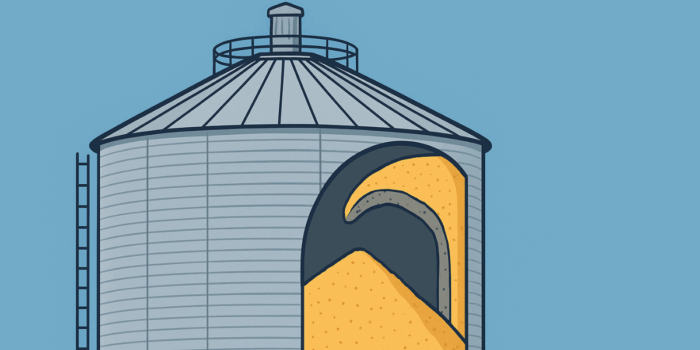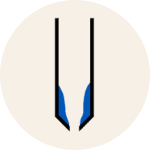
Silo Blockages, Clogging, and How to Address Them
Silo blockages are more than just a maintenance headache—they’re a serious risk to safety, productivity, and structural integrity. Left unaddressed, they can lead to grain spoilage, dangerous pressure buildup, and even full structural failure. In this post, we’ll explore what causes blockages, how to spot them, how to address them safely, and when it’s time to call in expert help.
Here is a summary of what we will cover:
- What Causes Silo Blockages?
- Warning Signs You May Have a Silo Blockage
- Consequences of Ignoring a Blockage
- Professional Help & Long-Term Prevention

What Causes Silo Blockages?
Silo blockages typically form due to environmental conditions, operational oversights, or material buildup inside the bin. Understanding the root causes is the first step toward preventing them.
Common Causes of Blockages
- Moisture Infiltration: High humidity, roof leaks, or condensation can lead to grain clumping and spoilage.
- Crusted Grain / Bridging: Grain hardens across the top layer, forming a false surface that prevents material beneath from flowing.
- Rat-Holing: Material flows only through a narrow central column while the rest of the grain remains stuck to the walls.
- Foreign Debris: Tools, broken parts, or packaging materials can obstruct chutes or flow paths.
- Poor Aeration: Lack of airflow causes uneven drying, leading to spoilage and compaction.
- Lack of Maintenance: Skipping cleanouts between fills allows residual material to build up and harden.
Types of Silo Blockages
Not all blockages are the same—here are the most common types encountered in silos and bins:

Ratholing
This occurs when the material has poor flow properties and doesn’t freely slide along the silo walls. Factors that can contribute to ratholing are material properties, silo design, and compaction.

Funneling
Funneling is a flow problem where material discharges only through a narrow, central path, leaving the rest of the material stagnant along the walls of the silo. Funneling still allows for some material to flow but in an inefficient and uneven manner. This is often caused by poorly designed silos, cohesive materials or lack of proper flow aids.

Bridging
Silo bridging occurs when the materials inside form a stable arch or bridge across the discharge outlet, blocking the flow. Sticky/cohesive materials clumping together or particles interlocking, create a blockage. If not addressed in a timely manner it can lead to downtime, material spoilage and potential structural stress.

Doming
With doming, the material forms a dome-like structure over the discharge outlet, preventing it from flowing. When cohesive materials stick together and to the walls, it can cause a blockage. This often happens because of moisture or compaction. Doming can lead to flow disruptions, uneven pressure on silo walls and material degradation.

Caking
Caking occurs when the material in the silo hardens into a solid mass, typically because of prolonged storage, high humidity, or moisture infiltration. The hardened material obstructs any discharge. This type of blockage can cause significant operational delays, material spoilage and equipment strain.

Plugging
Plugging happens when the material fully blocks the discharge outlet, hopper, or chute, preventing any time of flow at all. This issue usually arises because of cohesive or compacted materials, oversized particles, or foreign objects lodged in the outlet. Plugging can cause complete operational shutdown so it is important to address this blockage promptly.

Buildup
When material gradually accumulates on the interior silo walls or hopper, this is called buildup. Buildup reduces the storage capacity and overall flow. This typically happens with sticky, moist, or fine materials that adhere to surfaces over time. Buildup can lead to other blockages, uneven flow, and contamination of new material.
Takeaway: Each of these blockages requires a different approach. Some can be handled from above using mechanical or pneumatic systems; others require confined space entry and removal by trained professionals.
Warning Signs You May Have a Blockage
Spotting the warning signs of a blockage early can be the difference between a quick fix and a full-blown emergency. These symptoms often develop slowly but escalate quickly, especially during peak storage or unloading times.
Key Red Flags:
- Sluggish or Interrupted Grain Flow: Flow that starts and stops or never reaches full volume may indicate bridging, rat-holing, or arching.
- Musty or Sour Odors: Unusual smells can signal spoilage, fermentation, or compaction that’s blocking ventilation.
- Visible Condensation on Bin Walls: Moisture buildup can lead to grain crusting, especially near the surface or outer walls.
- Uneven Grain Levels: If grain appears sloped, sunken, or unusually flat across the top, a bridge or partial blockage may be present.
- Temperature Spikes Inside the Grain Mass: Sudden increases in heat, especially near the center, suggest spoilage or microbial activity that can clump grain together.
- Unusual Noises During Discharge: Popping, groaning, or air suction sounds can point to vacuum pockets or blocked chutes.
- Dust Plumes or Pressure Release: Sudden dust surges may be a sign that a blockage has partially broken loose under pressure.
Diagnostic Tools That Can Help
Investing in early detection tools can prevent a costly intervention:
- Temperature Cables: These monitor internal silo temps at different levels and can alert you to hotspots forming due to spoilage or compaction.
- Moisture Sensors: Detect excessive humidity inside the bin that could lead to crusting.
- Grain Flow Monitors: Alert you when grain flow deviates from expected rates during discharge.
- Bin Level Indicators: Show irregularities in volume or levels that suggest bridging or rat-holing.
Pro Tip: Blockages rarely fix themselves. If you see signs of reduced flow, investigate immediately. A delay of just a few days can turn a minor blockage into a structural or safety emergency.

Consequences of Ignoring Silo Blockages and Clogging
Silo blockages don’t just delay operations, they create a dangerous cascade of problems that can lead to structural damage, product loss, and even deadly accidents. If left unaddressed, what starts as a slow grain flow can quickly escalate into a facility-wide emergency.
Operational Disruption
A blocked silo brings everything to a halt. You can’t unload, process, or ship your commodity—leading to:
- Missed delivery schedules and lost revenue
- Idle crews and wasted labor costs
- Backup across your grain handling or production systems
In peak harvest or shipping season, every hour matters. Even a short delay can snowball into major logistical problems for downstream partners and buyers.
Structural Stress and Silo Failure
Blocked material often builds unevenly inside the bin. This causes asymmetrical pressure on the walls, leading to:
- Bulging or buckling of silo panels
- Stress cracks in concrete walls
- Deformation of discharge cones or unloaders
- In severe cases, full bin collapse
Bridging and rat-holing concentrate loads in ways your silo was never designed to handle. And once deformation begins, structural integrity may be permanently compromised. This risk is especially high in older bins or those not rated for heavy-flow resistance.
Explosion or Fire Hazard
Blocked silos trap more than just grain—they trap heat, pressure, and combustible dust. If left unresolved, the conditions may trigger:
- Internal grain heating or fermentation
- Dust cloud formation in confined space
- Flash fires or full dust explosions from static sparks, friction, or electrical malfunctions
Just one ignition source—like a hot bearing, electrical arc, or even static discharge—can cause an explosion if dust concentration is high enough.
Read our blogs, Why Grain Dust Explosions Happen: Understanding Causes, Prevention, and Safety and Grain Fires and Explosions: Yearly Trends, Causes, and Prevention for more information on this topic.
Financial & Commodity Loss
In some cases, blockages lead to spoilage or contamination. If water, mold, or insects infiltrate the silo due to improper flow, you may face:
- Partial or total commodity loss
- Price deductions at the elevator
- Expensive disposal of unusable material
- Re-cleaning or retrofitting costs for the silo
Pro Tip: Don’t wait for a blockage to become a disaster. West Side Salvage provides 24/7 emergency response, grain recovery, and maintenance services for silo blockage incidents of all types.

Professional Help & Long-Term Prevention
Not all blockages can—or should—be cleared by in-house teams. And even if they can, it pays to prevent them in the first place.
When to Bring in a Professional Crew
- The blockage involves hardened, crusted grain several feet deep
- The silo shows signs of structural strain or shifting
- Entry requires confined space certification or fall protection
- Your team lacks the equipment for safe removal
- Time is critical and downtime is costly
Long-Term Prevention Tips
- Clean out silos completely between fills
- Regularly inspect for crusts, bridging, or foreign objects
- Install and monitor aeration systems
- Use temperature and humidity sensors to catch issues early
- Schedule annual structural integrity inspections
Takeaway: When silo blockages threaten safety or operations, calling trained professionals isn’t just the safest option—it’s the fastest way to restore flow and protect your investment.

Need Help With a Blocked or Clogged Silo?
Silo blockages can go from frustrating to dangerous in a matter of hours. Whether you’re facing grain compaction, crusted bridges, rat-holing, or full structural flow failure, the risks are too great to ignore. Downtime impacts your bottom line, and improper removal methods can jeopardize worker safety and silo integrity.
At West Side Salvage, we specialize in fast, safe, and effective blockage removal services. Our crews are trained in confined space entry, structural safety, and grain recovery and are ready to respond 24/7 across the Midwest and beyond. From high-capacity commercial silos to farm bins and processing facilities, we’ve seen it all—and cleared it all.
We don’t just solve the problem, we help you recover valuable product, minimize long-term damage, and prevent future blockages through expert guidance and support.